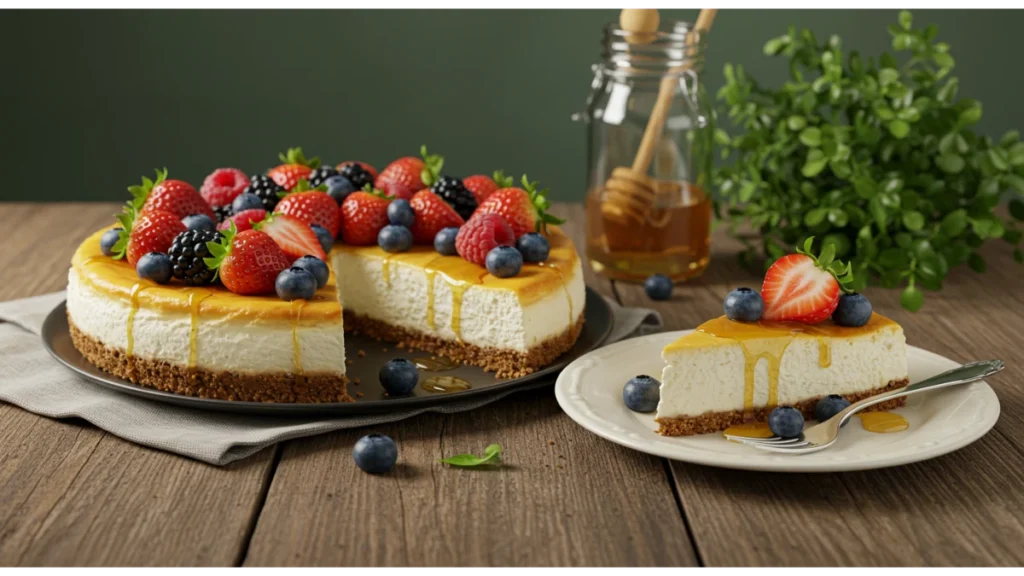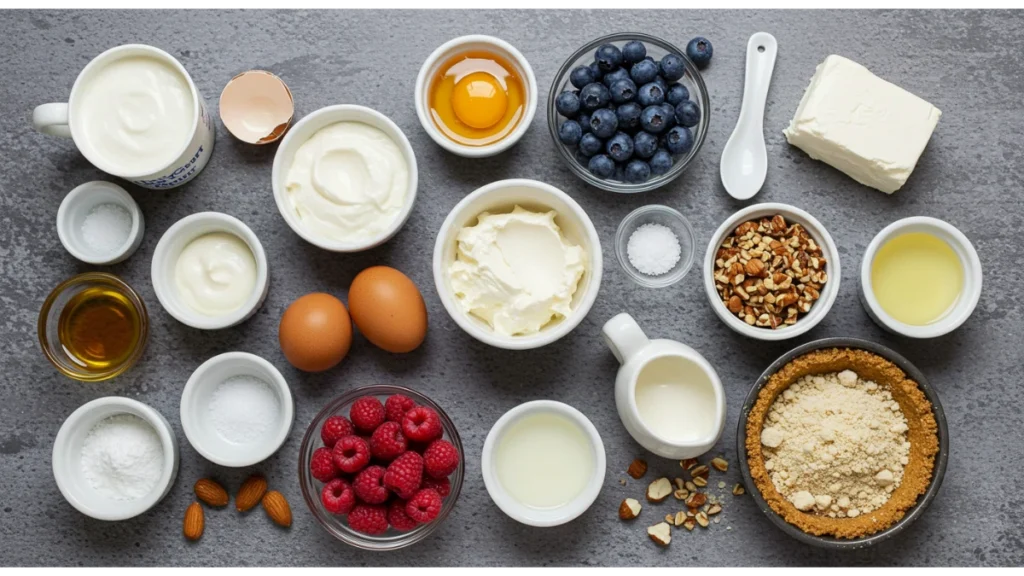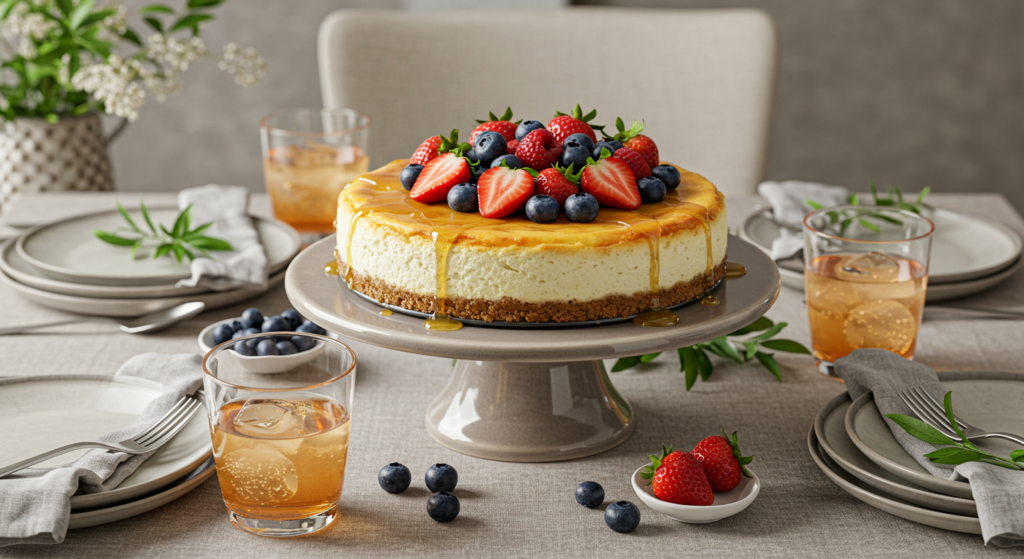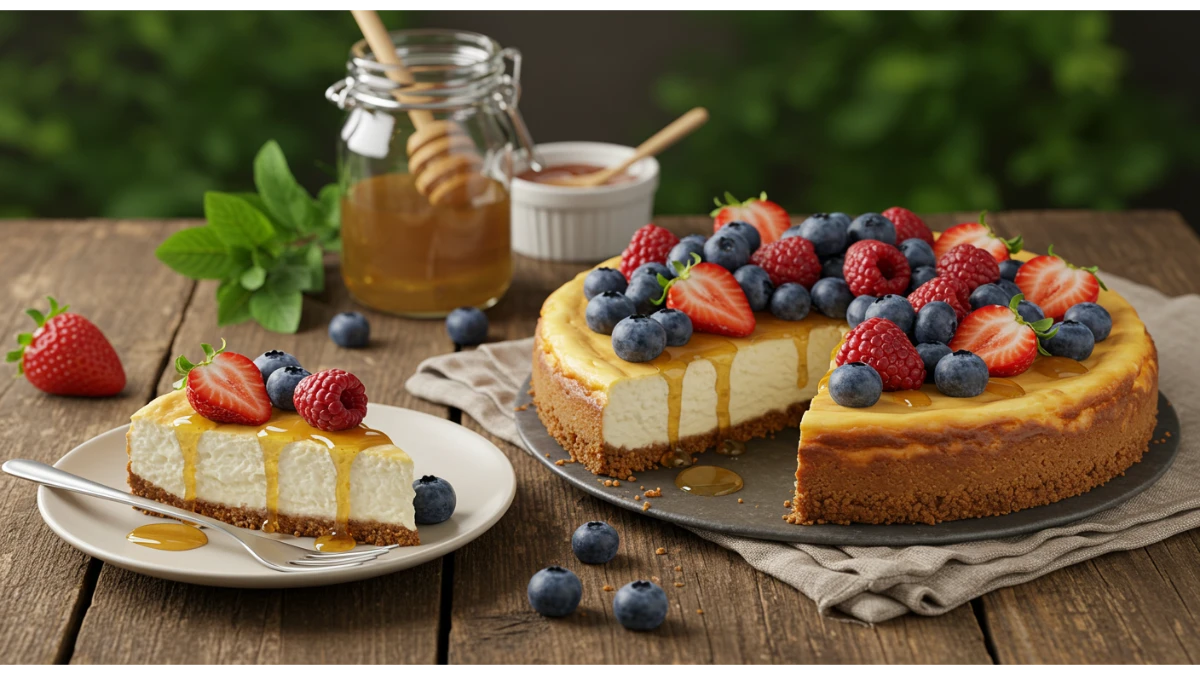The Best Healthy Cheesecake Recipe: Indulge Guilt-Free!
Healthy Cheesecake Recipe
Cheesecake is a beloved dessert enjoyed by many around the world, often associated with rich flavors and indulgence. However, the traditional version can be high in calories and sugar, leading many to shy away from this delightful treat. With the rise of health-conscious eating and the increasing awareness of nutrition, finding ways to enjoy this classic dessert without the guilt has become essential. Enter the healthy cheesecake—a delightful alternative that allows you to indulge your sweet tooth while still adhering to your dietary goals.
In this comprehensive guide, I will share my ultimate healthy cheesecake recipe, packed with flavor yet light on calories. Whether you’re looking to impress guests at a dinner party or simply satisfy your cravings, this recipe will transform your dessert game. We’ll explore not only the recipe itself but also the nutritional benefits, variations, and tips to ensure your cheesecake turns out perfectly every time. So, let’s dive into the delicious world of healthy cheesecake!
Key Aspects of Healthy Cheesecake

Healthy cheesecake doesn’t mean sacrificing taste or texture. By using nutritious ingredients, we can create a dessert that is both satisfying and good for you. Here are some key aspects to consider when making a healthy cheesecake:
- Ingredient Substitutions: One of the best ways to make a cheesecake healthier is to substitute traditional ingredients with lighter alternatives. For example, using Greek yogurt instead of cream cheese can significantly reduce fat content while adding protein. Greek yogurt is also rich in probiotics, which are beneficial for gut health.
- Natural Sweeteners: Instead of refined sugars, consider using natural sweeteners like honey, maple syrup, or stevia. These alternatives not only lower the calorie count but also provide additional nutrients and antioxidants. Each sweetener brings its unique flavor profile, allowing you to customize your cheesecake to your taste.
- Crust Alternatives: Traditional cheesecake crusts are often made from graham crackers, which can be high in sugar and gluten. By using almond flour, oats, or even crushed nuts, you can create a gluten-free and lower-carb crust that adds a nutty flavor and healthy fats.
- Add Healthy Ingredients: Consider incorporating superfoods like chia seeds or berries into your cheesecake. Not only do they enhance the flavor and texture, but they also boost the nutritional profile of your dessert. For example, chia seeds are high in omega-3 fatty acids, fiber, and protein.
- Portion Control: One of the easiest ways to enjoy cheesecake without overindulging is to control your portions. By cutting your cheesecake into smaller slices or even making mini cheesecakes, you can enjoy the rich flavors without consuming too many calories at once.
- Flavor Enhancements: Don’t hesitate to experiment with flavors! Adding citrus zest, cocoa powder, or spices like cinnamon can elevate your cheesecake to new heights. These additions can provide depth and complexity, making your healthy cheesecake even more enjoyable.
Ingredients You’ll Need for Healthy Cheesecake

To make a delicious and healthy cheesecake, you will need the following ingredients:
- 1 cup of Greek yogurt: High in protein and probiotics, Greek yogurt adds creaminess and a tangy flavor.
- 1 cup of low-fat cream cheese: This provides the classic cheesecake texture while keeping the calorie count lower than regular cream cheese.
- 1/2 cup of honey or maple syrup: These natural sweeteners provide sweetness without the refined sugars.
- 2 large eggs: Eggs help bind the ingredients together and give the cheesecake structure.
- 1 teaspoon vanilla extract: Adds a delightful flavor that complements the other ingredients.
- 1 cup of almond flour (for the crust): A gluten-free option that adds healthy fats and a nutty flavor.
- 1/4 cup of melted coconut oil: This helps bind the crust and adds healthy medium-chain triglycerides (MCTs).
- A pinch of salt: Enhances the overall flavor of the cheesecake.
- Optional toppings: Fresh berries, chocolate drizzle, or crushed nuts for garnish.
Nutritional Information
Here’s a breakdown of the nutritional content per serving of the healthy cheesecake (based on 12 servings):
| Nutrient | Amount per Serving |
|---|---|
| Calories | 180 |
| Total Fat | 9g |
| Saturated Fat | 4g |
| Cholesterol | 40mg |
| Sodium | 150mg |
| Total Carbohydrates | 20g |
| Dietary Fiber | 2g |
| Sugars | 8g |
| Protein | 6g |
Step-by-Step Instructions to Make Healthy Cheesecake
Now that we have our ingredients ready, let’s go through the step-by-step process of making this healthy cheesecake:
- Preheat the Oven: Start by preheating your oven to 325°F (160°C). This ensures that your cheesecake bakes evenly.
- Prepare the Crust: In a mixing bowl, combine the almond flour, melted coconut oil, and a pinch of salt. Stir the mixture until all components are thoroughly blended and have a consistency similar to damp sand. Firmly pack this blend into the base of a greased springform pan to create the crust. Make sure to pack it tightly for a sturdy base.
- Mix the Filling: In another bowl, beat the Greek yogurt, low-fat cream cheese, honey (or maple syrup), eggs, and vanilla extract until smooth and creamy. Use an electric mixer or a whisk to ensure there are no lumps. The mixture should be velvety and well combined.
- Combine and Pour: Pour the filling over the prepared crust, spreading it evenly with a spatula. Tap the pan gently on the counter to release any air bubbles that may have formed in the filling.
- Bake: Place the cheesecake in the preheated oven and bake for 30-35 minutes, or until the edges are set but the center is slightly jiggly. The cheesecake will continue to cook as it cools, so don’t overbake it.
- Cool Down: Once an hour has passed, take the cheesecake out of the oven and allow it to cool to room temperature. After it has cooled, refrigerate for at least 4 hours or overnight to allow it to set properly.
- Serve: Before serving, top your cheesecake with fresh berries, a drizzle of melted dark chocolate, or crushed nuts for added flavor and presentation. Slice into pieces and enjoy!
Benefits of Healthy Cheesecake

Healthy cheesecake is not just a delicious treat; it also comes with several benefits:
- Nutrient-Rich: By using Greek yogurt and almond flour, you’re adding protein and healthy fats to your dessert. This makes it more satisfying and nutritious than traditional cheesecakes.
- Lower Caloric Intake: This version is significantly lower in calories than traditional cheesecake, allowing you to enjoy dessert without the guilt. This dessert is an excellent choice for individuals mindful of their calorie intake.
- Versatile: You can easily adapt the recipe to suit various dietary needs, making it a crowd-pleaser. Whether you need a gluten-free, low-carb, or vegan option, there are plenty of ways to modify this recipe.
- Easy to Prepare: With simple steps and accessible ingredients, this recipe is perfect even for beginners in the kitchen. You’ll impress your friends and family with minimal effort.
- Satisfies Sweet Cravings: This healthy cheesecake allows you to indulge your sweet tooth while still sticking to your health goals. It’s a great way to enjoy dessert without compromising your diet.
- Probiotic Benefits: The use of Greek yogurt not only adds creaminess but also provides beneficial probiotics that can support gut health.
- Rich in Healthy Fats: The almond flour and coconut oil used in the crust contribute healthy fats that can help keep you feeling full longer.
Overcoming Challenges
While making healthy cheesecake is relatively straightforward, here are some common challenges and tips to overcome them:
- Crust Issues: If your crust crumbles, try adding a bit more melted coconut oil to help it bind. You can also pre-bake the crust for 5-10 minutes to ensure it holds together better.
- Filling Too Runny: Ensure you’re using full-fat cream cheese and allow the cheesecake to cool completely before refrigerating. If it’s still too runny, consider adding a tablespoon of cornstarch to the filling to help it set.
- Cracks on Top: To prevent cracking, avoid overmixing the filling and ensure the oven temperature is accurate. Letting the cheesecake cool slowly in the oven can also help minimize cracks.
- Flavor Issues: If your cheesecake lacks flavor, consider adding more vanilla extract, lemon juice, or even a pinch of salt to enhance the overall taste.
- Baking Time: Baking times can vary based on your oven and the type of pan you use. Always keep an eye on the cheesecake to prevent overbaking.
Future Trends in Cheesecake
As health trends continue to evolve, expect to see more innovative cheesecake recipes that incorporate superfoods, alternative flours, and plant-based ingredients. The demand for vegan and gluten-free options will likely grow, leading to exciting new variations on this classic dessert.
For instance, we might see cheesecakes made with cashew cream or coconut cream as a base, catering to those following a plant-based diet. Additionally, flavor trends such as matcha, turmeric, and other superfood powders could become popular additions to cheesecake recipes, enhancing both the nutritional profile and visual appeal.
Emerging Ingredients
- Plant-Based Cream Cheeses: With the rise of veganism, plant-based cream cheeses made from nuts, soy, or coconut are becoming more popular, allowing for vegan cheesecake options that still taste rich and creamy.
- Alternative Sweeteners: As people become more health-conscious, sweeteners like monk fruit and erythritol are gaining traction as low-calorie alternatives to sugar.
- Superfood Additions: Ingredients such as spirulina, acai powder, and matcha are being incorporated into cheesecakes for added health benefits and vibrant colors.
- Functional Ingredients: Expect to see more cheesecakes featuring ingredients that promote wellness, such as adaptogens like ashwagandha or reishi mushrooms, which are known for their stress-reducing properties.
- Seasonal Flavors: Seasonal ingredients like pumpkin spice in the fall or fresh berries in the summer will continue to inspire cheesecake variations, keeping the dessert exciting year-round.
Tips and Tricks Section
- Flavor Enhancements: Consider adding lemon zest or cocoa powder to the filling for a unique twist. Lemon zest adds a refreshing brightness, while cocoa powder gives a rich chocolate flavor.
- Storage Recommendations: Keep any leftover cheesecake in a sealed container in the refrigerator for a maximum of five days. If you want to keep it longer, you can freeze individual slices wrapped in plastic wrap and then placed in a freezer bag.
- Freezing: You can freeze slices for a quick dessert option. Just thaw them in the refrigerator before serving. This makes it easy to have a healthy dessert on hand whenever you need it.
- Personalization: Feel free to customize the recipe with your favorite flavors. Add spices like cinnamon or nutmeg, or incorporate fruit purees into the filling for added sweetness and flavor.
- Serving Suggestions: Serve your cheesecake with a scoop of low-fat ice cream or a dollop of whipped cream for an extra indulgent experience. You can also pair it with a cup of herbal tea or coffee for a delightful dessert experience.
Variations and Adaptations
- Vegan Option: Substitute eggs with flax eggs (1 tablespoon ground flaxseed mixed with 3 tablespoons water = 1 egg) and use dairy-free cream cheese for a completely vegan cheesecake. You can also use silken tofu blended until smooth as a base.
- Low-Carb Version: Use a crust made from ground pecans or walnuts for a keto-friendly dessert. This not only reduces carbs but also adds a delicious nutty flavor.
- Fruit Swirl: Add a fruit puree (like raspberry or blueberry) to the filling before baking for a colorful and fruity twist. Swirl it in gently for a marbled effect.
- Chocolate Cheesecake: Incorporate cocoa powder into the filling for a rich chocolate cheesecake. Top with dark chocolate shavings for an elegant presentation.
- Citrus Cheesecake: Add orange or lemon juice and zest to the filling for a refreshing citrus flavor. This brightens up the cheesecake and makes it perfect for spring and summer gatherings.
- Spiced Cheesecake: Incorporate spices like cinnamon, nutmeg, or ginger for a warm, spiced flavor profile. This variation is particularly delightful during the fall and winter months.
- Nutty Cheesecake: Fold in crushed nuts or nut butter into the filling for added texture and flavor. Almonds, pecans, or hazelnuts work wonderfully in this recipe.
- Savory Cheesecake: For a unique twist, consider making a savory cheesecake by incorporating herbs and spices. A goat cheese cheesecake with rosemary and thyme can serve as an elegant appetizer.
FAQs
Can I substitute Greek yogurt?
Yes, you can use regular yogurt or a dairy-free alternative, but it may alter the texture slightly. Greek yogurt is recommended for its creaminess.
How can I make this cheesecake sweeter?
Adjust the quantity of honey or maple syrup according to your preferred sweetness level. You can also add a bit of stevia or monk fruit sweetener for additional sweetness without the calories.
What’s the best way to store leftovers?
Store them in a sealed container in the refrigerator for up to five days. You can also freeze slices for longer storag
Can I prepare this cheesecake in advance?
Absolutely! This cheesecake keeps well in the refrigerator for several days, making it an excellent choice for meal prep or special occasions.
Is this cheesecake suitable for kids?
Yes, this healthy cheesecake is perfect for kids! It’s delicious and nutritious, making it a great dessert option for the whole family.
Is it possible to substitute another type of flour for the crust?
Yes! You can use oat flour, coconut flour, or even gluten-free all-purpose flour as alternatives to almond flour.
What can I use instead of eggs?
For a vegan option, you can use flax eggs (1 tablespoon ground flaxseed mixed with 3 tablespoons water equals 1 egg) or applesauce (1/4 cup per egg).
How do I know when the cheesecake is done?
The outer edges should be firm, while the center remains slightly wobbly.
Conclusion
This healthy cheesecake recipe is a game-changer for dessert lovers looking to indulge without guilt. With its rich flavors and nutritious ingredients, you can satisfy your cravings while still adhering to your health goals. Whether you serve it at a party, a family dinner, or simply as a treat for yourself, this cheesecake is sure to impress.
Remember, the key to a successful cheesecake lies in the quality of your ingredients and the care you take in preparing it. Don’t hesitate to experiment with flavors and toppings to make it your own. Relish the experience, and above all, savor each delightful bite!
So, gather your ingredients, preheat your oven, and get ready to create a dessert that not only tastes amazing but also nourishes your body. Don’t forget to share your creations and variations in the comments below, and subscribe for more delicious recipes!

